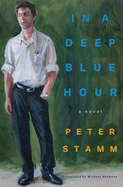
What's a better world to live in: the real one or an imagined one lived in one's head? The Swiss author Peter Stamm (Agnes; The Archive of Feelings) brilliantly plays with these and other philosophical concepts in his sly novel In a Deep Blue Hour, translated from the German by Michael Hofmann. Andrea, a 40-something filmmaker whose credits include "one or two little films for museums," travels to Paris to make a documentary about Richard Wechsler, a Swiss writer. He's a slippery character, often failing to show up at the agreed-upon shooting location. That's annoying but not surprising, given that he says the best way out of bad situations is to leave: "As long as you stay on the move, not much can happen to you."
Wechsler ends up torpedoing the project by backing out of it, even though he and Andrea had developed a close bond. But Stamm is too crafty to leave the story there. Andrea tracks down Judith, a 60-ish married minister who was Wechsler's romantic partner when they were around 20 and who, in various guises, has appeared in Wechsler's novels. After Wechsler dies, the remainder of In a Deep Blue Hour documents Andrea's further investigations into his life. Ever the filmmaker, she concocts fictitious scenes involving Wechsler, including a romance between them. All of this is in keeping with Stamm's exploration of the nature of art and the motivations of artists who co-opt the world around them. Can a work of art ever capture the truth? Wechsler asks. Who knows, but Stamm tries in this impeccable work. --Michael Magras, freelance book reviewer

